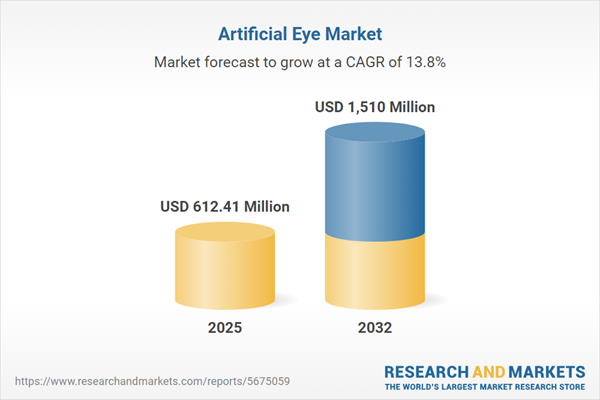Speak directly to the analyst to clarify any post sales queries you may have.
The artificial eye market is entering a period of structured, technology-driven transformation, with material science innovations and digital healthcare built into product development and patient care delivery. For senior decision-makers, precise intelligence on artificial eye market trends is central to navigating change, evaluating strategic opportunities, and prioritizing future investments.
Market Snapshot: Artificial Eye Market Size and Growth
The artificial eye market is progressing from a valuation of USD 537.22 million in 2024 to USD 612.41 million in 2025. By 2032, it is expected to reach USD 1.51 billion, reflecting a robust compound annual growth rate (CAGR) of 13.82%. Expansion is powered by advancements in prosthetic technologies, greater reach of clinical applications across healthcare infrastructure, and significant investment in manufacturing automation. Top industry participants are integrating digital platforms and establishing standardized clinical care frameworks to reinforce operational efficiency and sector-wide resilience within healthcare markets.
Scope & Segmentation
This report provides actionable market segmentation to support senior leaders, commercial planners, and operations teams in setting agile strategies and optimizing risk. The segmentation framework reflects both established and emerging opportunities in the artificial eye market:
- Product Type: CAD/CAM-based custom prostheses, traditional handcrafted products, and widely adopted standardized prosthetic models address needs ranging from unique clinical cases to mainstream patient care.
- End User: Ambulatory service providers, hospitals, and ocular clinics anchor the patient journey from acute intervention to ongoing rehabilitation and follow-up.
- Application: Cosmetic and therapeutic uses—such as trauma treatment and post-surgical rehabilitation—expand patient access and enhance specialist outcomes in targeted care settings.
- Material: Solutions leveraging polymethyl methacrylate, silicone, and other medical-grade materials ensure safety and device longevity, supporting both routine and complex clinical scenarios.
- Regions: Commercial opportunities and complex regulatory environments exist throughout the Americas (notably the United States, Canada, Mexico, and Brazil), Europe, the Middle East, Africa, and the Asia-Pacific.
- Leading Companies: Art of Vision Group, Steeper Group, Aurora Prosthetics, OFA – Ocular Prosthetics, Eye-Tech Care, Keniston Group, Ramachandran & Co., Jinan Yingshun Prosthetics, Beijing Kangli Medical, and Trulife Prosthetics each drive innovation, production scale, or clinical adoption.
This segmentation equips organizations to address evolving clinical workflows, anticipate shifting regulatory landscapes, and simplify procurement and reimbursement processes. Digital integration within procurement and supply chains further strengthens the capacity for real-time, data-driven decisions. The report’s focus on these segments ensures broad relevance across both technology-focused and regionally diversified operations.
Artificial Eye Market Trends: Key Takeaways
- Digital manufacturing adoption is accelerating the customization of prosthetic devices and streamlining supply processes, supporting more effective service delivery across care sites.
- Collaboration between clinicians, materials specialists, and engineers drives steady advances in device performance, quality control, and post-implementation outcomes.
- Integrated rehabilitation frameworks are strengthening long-term patient outcomes and promoting tailored engagement across different provider types.
- Building a network of adaptable supply and production partners facilitates rapid, coordinated responses to changing market or policy conditions.
- Active involvement in regulatory policy groups allows industry leaders to maintain ongoing market access as standards and requirements adjust to new technologies.
- Supply chain agility—supported by regional and local resource management—is increasingly vital to managing compliance, logistics, and evolving payer expectations.
Assessing Tariff Impact and Competitive Responses
Since 2025, tariff changes in the United States have led to increased materials costs and extended supply lead times. Market leaders are adapting by enhancing domestic manufacturing capabilities and expanding supplier bases to mitigate risk. Focusing on local sourcing and flexibly engineered service models allows companies to align with new reimbursement protocols and evolving regulatory requirements. This responsiveness supports consistent operational performance even as global trade conditions fluctuate.
Methodology & Data Sources
Insights presented are drawn from peer-reviewed scientific research, regulatory filings, and direct commentary from clinicians, academic researchers, and supply chain experts. External third-party validation verifies that analysis aligns with real-world procurement criteria and executive decision priorities across multiple healthcare systems.
Why This Report Matters
- Equips executive teams with clear, data-backed analysis to synchronize product development with shifting digital healthcare and regulatory trends.
- Enables targeted commercial strategy across products and regions—whether expanding portfolios or navigating new compliance requirements.
- Facilitates informed supply chain management and strategic partnerships designed for sustainable growth and risk mitigation.
Conclusion
Technology, cross-disciplinary collaboration, and focused market segmentation are shaping the future direction of the artificial eye market. Executives who apply data-driven approaches will be positioned for resilient growth and proactive adaptation as the sector evolves.
Additional Product Information:
- Purchase of this report includes 1 year online access with quarterly updates.
- This report can be updated on request. Please contact our Customer Experience team using the Ask a Question widget on our website.
Table of Contents
3. Executive Summary
4. Market Overview
7. Cumulative Impact of Artificial Intelligence 2025
List of Figures
Samples

LOADING...
Companies Mentioned
The key companies profiled in this Artificial Eye market report include:- Art of Vision Group, Inc.
- Steeper Group Ltd.
- Aurora Prosthetics, Inc.
- OFA – Ocular Prosthetics Ltd.
- Eye-Tech Care Sp. z o.o.
- The Keniston Group, Inc.
- Ramachandran & Co. (India) Pvt. Ltd.
- Jinan Yingshun Prosthetics Manufacturing Co., Ltd.
- Beijing Kangli Medical & Scientific Instrument Co., Ltd.
- Trulife Prosthetics, Inc.
Table Information
| Report Attribute | Details |
|---|---|
| No. of Pages | 193 |
| Published | October 2025 |
| Forecast Period | 2025 - 2032 |
| Estimated Market Value ( USD | $ 612.41 Million |
| Forecasted Market Value ( USD | $ 1510 Million |
| Compound Annual Growth Rate | 13.8% |
| Regions Covered | Global |
| No. of Companies Mentioned | 11 |









